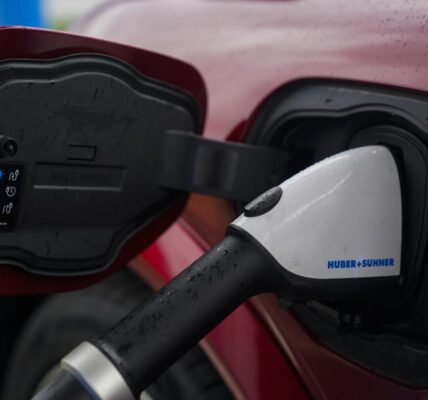Southern California’s Salton Sea may be sitting atop a lithium gold mine that, if extracted, could power a staggering 375 million electric vehicle batteries, according to a new report.
It’s not exactly a secret that lithium is present in the hot brine located in the shallow, landlocked body of water’s vast underground reserve. But the report, funded by the U.S. Energy Department, is the first time scientists have estimated just how much could be present.
And if estimates are correct, the amount is gargantuan.
Researchers found that an estimated 18 million metric tons of lithium carbonate is available in the underground pool, which is not connected to the surface lake. For reference, that enough to power more electric vehicles than are currently on U.S. roads, the Energy Department said.
The substance, often referred to by its nickname of “white gold” because of its silvery-white look, has come into demand in recent years amid the growing prevalence of electric vehicles.
As electric vehicles continue to replace traditional gas guzzlers, study co-author Michael Mckibben said the “significant” discovery could completely redefine how the U.S. obtains lithium, which is almost entirely imported.”
It makes this among the largest lithium brine deposits in the world,” Mckibben, a geochemist at the University of California, Riverside, told the Desert Sun, a USA TODAY Network publication. “This could make the U.S. completely self-sufficient in lithium so we’re no longer importing it via China.”
Drilling for lithium and geothermal began in November 2021 at the Salton Sea in an area known for geothermal energy production near Niland, Calif.
Lithium is a critical component that powers not just electric vehicles, but other batteries for everything from smartphones to solar panels.
Geothermal brines, a byproduct of geothermal electricity generation, often have high concentrations of minerals like lithium and zinc, according to the Energy Department. For years, companies large and small have been swarming California’s largest lake in a rural region that’s already touting itself as Lithium Valley. And now that perhaps the highest concentration of lithium could be in the saline-heavy Salton Sea in California’s Riverside and Imperial counties, politicians and private companies alike will be taking even more interest.
A key component of turning the Salton Sea region into what Gov. Gavin Newsom has called the “Saudi Arabia of lithium” will rely on companies figuring out how to extract the lithium from this geothermal brine at commercial scale. Separating the lithium from geothermal brine is considered less invasive than blasting and other hard rock mining done in Australia, or huge, open air evaporation pounds in South America. Successfully doing so could prove critical to meeting President Joe Biden’s goal of 50% electric vehicle adoption by 2030.”
This report confirms the once-in-a-generation opportunity to build a domestic lithium industry at home,” Jeff Marootian, principal deputy assistant secretary for the Energy Department’s Office of Energy Efficiency and Renewable Energy, said in a statement. “Using American innovation, we can lead the clean energy future, create jobs and a strong domestic supply chain, and boost our national energy security.”
The Salton Sea Geothermal Resource Area has about 400 megawatts of geothermal electricity generation capacity installed, and is estimated to have the potential for up to 2,950 megawatts.
Controlled Thermal Resources is one of three companies working on projects to extract lithium at commercial scale near the Salton Sea. In an emailed statement to The Desert Sun, company CEO Rod Colwell said the report “substantiates the robustness and scale of the Salton Sea resource” and “confirms much larger lithium reserves than originally thought.”








